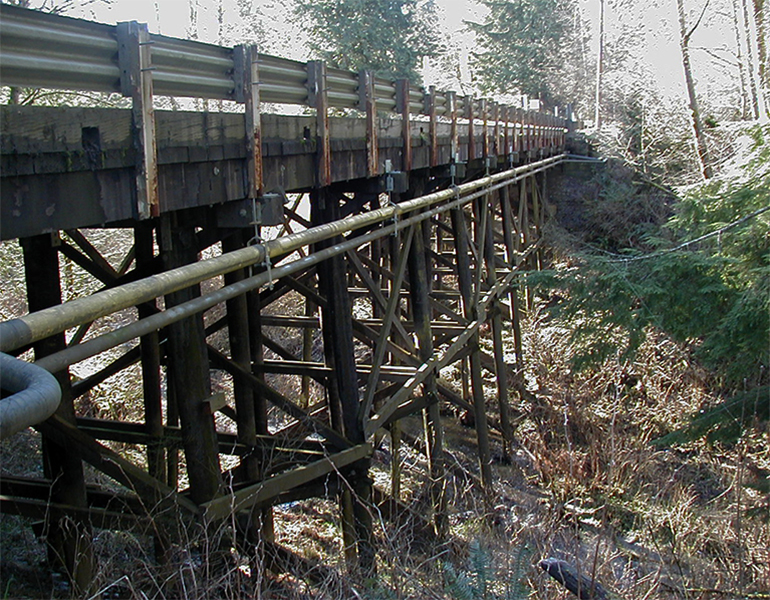Vehicle weight restrictions for bridges in unincorporated King County

Example of a weight restricted bridge. The Ames Lake Trestle Bridge was built nearly 100 years ago and was originally designed with narrow lanes for much smaller vehicles compared with what we see on the road today. The bridge has a posted weight restriction for specific large trucks and specialized hauling vehicles. A project to replace Ames Lake Trestle Bridge is anticipated to begin in spring 2024.
Overview
This page provides the latest updates on bridges with weight restrictions and links to complete lists of bridges with vehicle weight, height, speed and other restrictions. Below are frequently-asked questions, the latest list of load limited bridges, and links to pertinent permit applications and webpages.
List of bridges with vehicle weight restrictions
- Ames Lake Trestle Bridge No. 1320A
Signage mapped | Area map (475KB) - Baring Bridge No. 509A
Signage mapped | Area map (903KB) - Boise X Connection Bridge No. 3055A
Signage mapped | Area map (856KB) - Deep Creek Bridge No. 364A
Signage mapped | Area map (470KB) - Evans Creek Bridge No. 180A
Signage mapped | Area map (545KB) - Green River Gorge Bridge No. 3032
Signage mapped | Area map (602KB) - Issaquah Creek Bridge No. 1741A
Signage mapped | Area map (541KB) - North Fork Road Bridge No. 1221
Signage mapped | Area map (882KB) - Patton Bridge No. 3015 - New
Signage mapped | Area map (618KB) - Scenic Bridge No. 999K2
Signage mapped | Area map (506KB)
Frequently asked questions
Key components:
• Requirement to rate bridge’s ability to carry four additional types of “special haul vehicles.” These are authorized vehicles on roadways that can have heavier loads.
• Requirement to evaluate and rate the gusset plates. A gusset plate is used in between the intersection of two columns or beams and in connection points on bridges with steel trusses.
No. Speed limits are not based on weight restrictions.
Many vehicles like school buses, fire engines and ambulances are still allowed depending on their weight and the loads they carry. We continue to update fire districts if and when there is a weight restriction or a new one is put in place. Truck companies and agencies can email the county at permits.roads@kingcounty.gov with questions and requests about specific bridges. Inquiries should include information about truck weights, including the weight of any loads, and information on how the vehicle distributes the weight (spacing between each axle and loads on each axle). If the truck, fully loaded, exceed legal loads, or posted load signs, companies or agencies can apply for “over legal load” permits. More about overlegal load permits.
Advanced warning signs and turn-around signs are posted on roadways to inform truck drivers that they are approaching a weight restricted bridge.

 Translate
Translate